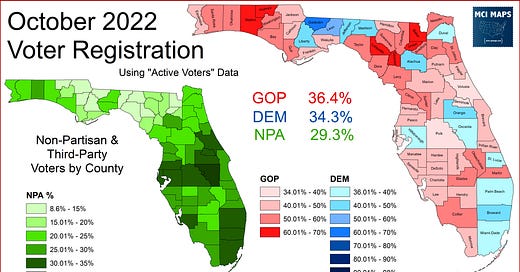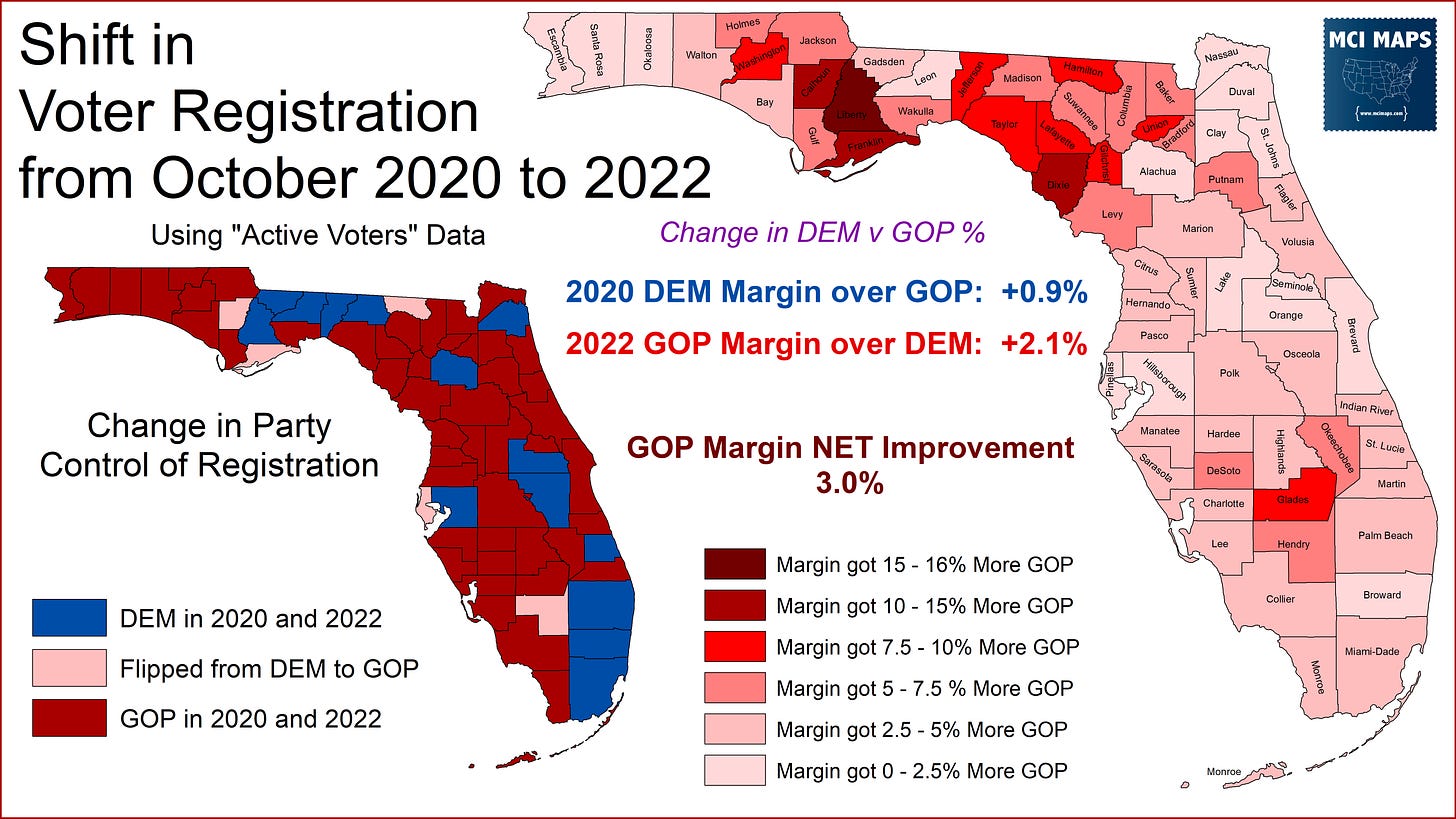Issue #74: Florida Republicans Toppled Democrats in Registration
The first general election with a GOP lead
Election Day in Florida is just over a week away, and its a historic election for the state. This year marks the first General Election in Florida where Republicans have led in voter registration. After taking the lead months ago, Republicans continued to the trend up as Democrats ticked down. The final figures give the GOP a 300,000 voter advantage.
Non-Partisan voters (which are being lumped in with the small number of 3rd party registrants) are at their highest share yet. They are on the very of becoming the largest voting block in Osceola county.
I broke down voter registration by state house district as well.
The house map shows where non-partisans are the largest voting block.
This is a long fall for the Florida Democratic Party. Voter registration has been narrowing since the 1980s, with many viewing the flip as inevitable. To be sure, Democrats were, for a long time, propped up by conservative, North Florida democrats who already had a history of voting GOP for big races. This GIF below highlights how registration has changed with time.
If we look at how registration changed since 2020, we see that the strongest GOP growth has been in the ancestrally-democratic Northern panhandle and the central farm counties.
To get an even more detailed view, I did this swing by state house district. This highlights that GOP improvements is not just about rural counties; though rural HD7 easily leads. Democrats, meanwhile, still managed to make narrow improvements in a batch of suburban and diversifying districts.
Orlando should be no shock, but some of you may be surprised about the north Clay district. This is prominent suburban area that is historically GOP that has tilted away from the MAGA movement. The region is also growing more racially diverse. Of course this area still is steadfast Republican.
Maybe Clay will be a swing county by 2074.
To be clear, the rural shift is not why Democrats are now down in voter registration. While Democrats have lost ground there, they have historically been gaining ground in urban centers, especially Central Florida. The fact is, Democrats are losing ground across the board.
Since 2020, the Democratic Party in Florida has shrunk by 331,000 people! The biggest drops were in major urban centers, not the sparsely-populated panhandle. The map below shows how the raw voter numbers shifted by Florida counties. All but one county had a NET GOP improvement. For example, while Democrats still edge Republicans in Miami-Dade, the shifts closed the gap for the GOP by 68,000! In only one county, Okaloosa, did Democrats shift the margin in their favor, though it remains solidly GOP in overall registration.
As the left-side graph shows, Democrats had a net loss of members across every county except Sumter. Note though that Sumter still showed a NET GOP advantage. While Democrats actually improved their totals in Sumter, the GOP registered more. Democrats have a net improvement in Okaloosa was more about the GOP losing more raw voters. Overall, there is no county where the Democrats can tip their hat and say “good job.” Every county is bad news.
The fact that Democrats are down 300,000 people while both Republicans and non-partisans are up is a historically bad showing. Improvements for Republicans in previous years has involved both parties going up in totals, with the GOP just going up more. During the 2008 and 2012 campaigns, Barack Obama’s Organizing for America apparatus registered hundreds of thousands of Democratically-aligned voters. Today, no organization with close to the same money exists. National groups have offered pennies for Florida, and the Democratic Party is at a monumental cash disadvantage. The result? No major voter registration program, and a worsening decline than expected.
Long-Term Trends
The 2020 to 2022 trend perfectly reflects the current dynamic in Florida and the party resource disparity. However, there are still other longer-term trends at play here. If we compare registration from 2016, which I view as the beginning of the “Trump era,” there is still a Democratic swing in several urban/suburban blocks. Democrats made improvements in the Jacksonville, Orlando, and Gainesville area.
The swing of the rural counties is even more pronounced in this map. Democrats still suffer from losing ground in Southeast Florida and the Tampa region. The lack of blue Osceola also highlights how Republicans are making inroads with Hispanic voters.
If we look at the 2016 comparison by raw voters (like we did with 2022), then we see that there are only 93,000 more Democrats today than back then. Both Republicans and Non-Partisans, meanwhile, have increased by 750,000. However, despite this gap, Democrats have actually improved their margin over the GOP in four counties.
That map really highlights the Democratic fortunes in Jacksonville and the Orlando/Seminole area. Democrats have managed to net voters in many of the urban and suburban coastal counties. However, they are down in Broward and Miami-Dade, which is a terrible sign.
I broke this raw vote change by House District as well.
The the long-term voter registration trends reflect long term voting pattern changes we have seen; and its not good for Democrats.
If the Florida Democratic Party does not see a massive investment of funds, then this registration gap will get worse, and Florida will further solidify as a GOP-dominated state.













